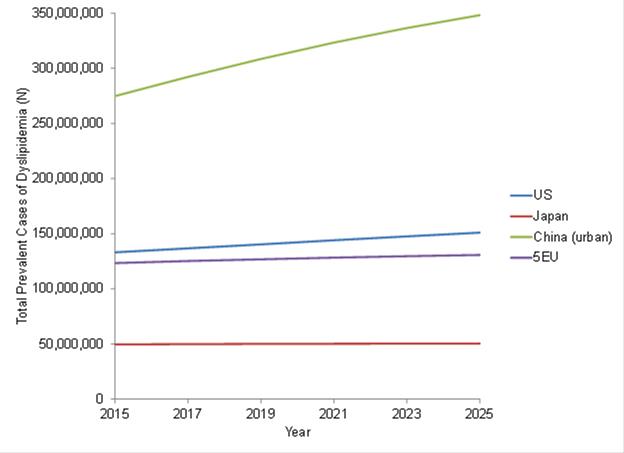Dyslipidemia is a condition in which one or more of the serum lipid levels are abnormal. These lipids include low-density lipoprotein cholesterol (LDL-C), triglycerides (TG), and high-density lipoprotein cholesterol (HDL-C). An individual is considered to have dyslipidemia when there is an observed elevation in LDL-C or TG, or a low concentration of HDL-C.
Figure 1 shows the change in total prevalent cases of dyslipidemia in the 8MM from 2015 to 2025. The number of cases in the 8MM is expected to increase from 580,825,262 in 2015 to 680,288,645 in 2025 at an annual growth rate (AGR) of 1.71%. Urban China is expected to see the highest growth of the 8MM, with an AGR of 2.67%. GlobalData epidemiologists do not expect any major changes in the underlying total prevalence rates for dyslipidemia across this time period for any of the 8MM; therefore any change in the number of cases is due to change in the underlying population at risk.
In addition to the underlying changes in population demographics, two major factors may impact the total prevalence of dyslipidemia during the next decade we had forecast: changes in the prevalence of risk factors for these serum lipid abnormalities, and market-specific changes in proactive treatment. Although an increasingly sedentary lifestyle may lead to increases in risk factors for dyslipidemia, such as obesity and physical inactivity, these increases may be countered in markets with health promotion campaigns encouraging people to exercise more and increase their physical activity.
Details about the trend and analysis and additional discussion of dyslipidemia epidemiology can be found in the EpiCast Report: Dyslipidemia – Epidemiology Forecast to 2025 and the EpiCast model.
Total Prevalent Cases of Dyslipidemia, Ages ≥20 Years, Both Sexes, N, Selected Years 2015–2025

How well do you really know your competitors?
Access the most comprehensive Company Profiles on the market, powered by GlobalData. Save hours of research. Gain competitive edge.

Thank you!
Your download email will arrive shortly
Not ready to buy yet? Download a free sample
We are confident about the unique quality of our Company Profiles. However, we want you to make the most beneficial decision for your business, so we offer a free sample that you can download by submitting the below form
By GlobalData







